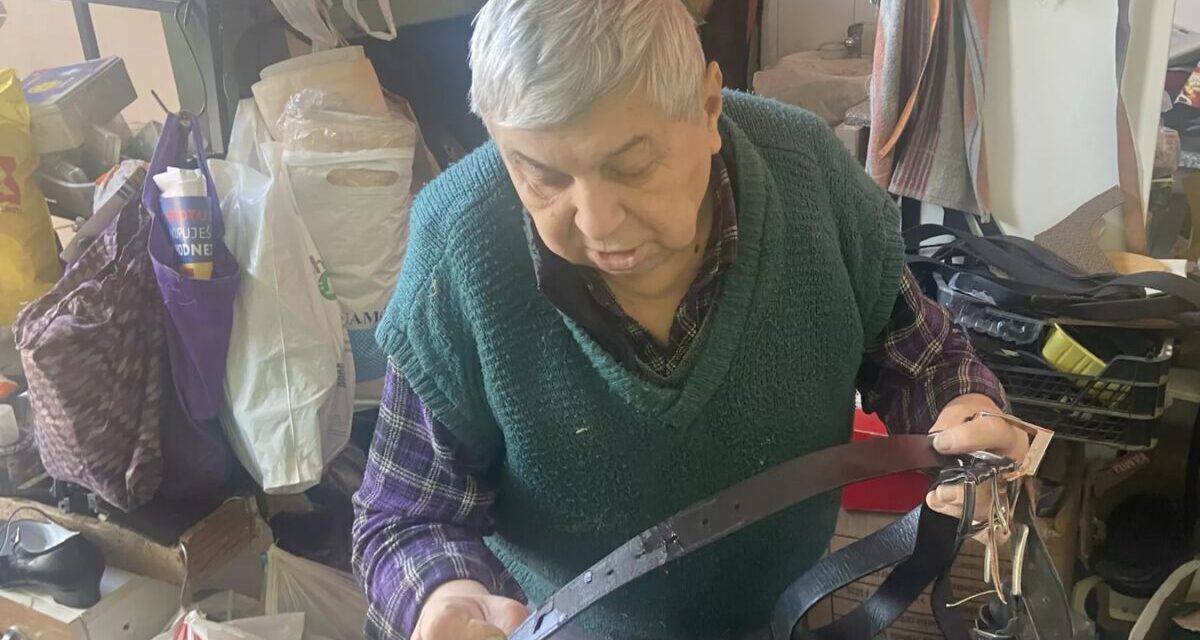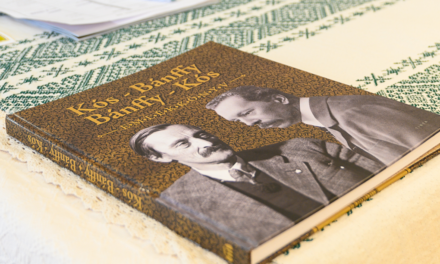That's the only way they call him in Somorján and its surroundings, Mr. Pint, and they praise him for his affordable and conscientious work.
A few years ago, it moved to a new location, to a room in the waiting room of the bus station in Somorja. Here, you take over the thing to be repaired through a small window. When I took my boots to be sharpened, I thought how good it is that there are still craftsmen like this in this hyper-modern world. I asked him why he chose this profession.
Unfortunately, I am disabled. One of my legs is shorter, I was born that way. I had to choose a profession that could be done while sitting. In 1960, I went to Nyitraszerdahely to study as a shoemaker. By the way, I come from Nagymegyer, and I am now in my seventy-ninth year. I've lived in shoes practically my whole life
Imre Pint, master shoemaker, readily answers.
But here's the key, feel free to come into the building, to my workshop - he hands out the key, then adds that since this building does not belong to the Slovak bus transport company, it has to be closed, no one can enter, even those waiting for the bus cannot use the toilet - explains.
It's very cold
I go into the tiny workshop, where it's only 13 degrees, but as the master says, it's still better than in the panel. He starts at seven in the morning in the summer, and at eight in the winter and works until five in the afternoon. Unfortunately, there is no heating in the room, so it is usually only 4 degrees when you arrive in the morning during winter. If you heat it all day with the little electric gadget, the workshop heats up to 13 degrees in the afternoon. He does his work like this for eight hours a day, but he's used to it.
You can't work in a big coat or gloves, I usually take hand sewing home, it's warmer there. One day it will be spring
he says confidently. He then returns to his school years.
He lived in a dormitory at the Nyitraszerdahely vocational school, he had to walk two kilometers from the train station every week, as the school was in a park. Various trades were taught here, there were locksmiths and chimney sweeps; students from all over the country. His roommates came from Kassa, Nagymihály and Érsekújvár.
What a small world! We had a teacher from Bratislava who also spoke Hungarian. He knew I was Hungarian, so he hugged me, I was his favorite. Unfortunately, he has already died, but his daughter moved to Somorja, and based on the old photographs, she approached me. Even today, when he goes there, he always knocks on the window to come in!
he announces proudly.
After learning the trade, he did not start working in Somorja.
In 1965, I had my first job in Dunaszerdahely, there were ten of us shoemakers and we barely made ends meet! There was an administrator who collected the shoes intended for repair next to the local headquarters of Csemadok, then pushed them to the cobblers at a loss and distributed the work. Then in 1968, I arrived here on a Pionier motorcycle to see Somorja. They said there was a vacancy. I liked this place, I didn't want to go anywhere else. Our workshop was opposite the then town hall. Florist, motorcycle winder, shoe repairer in one place, four of us cobblers.
At the time, I was still living in Nagymegyer, where I met my wife and got married in 1969. For one year I went to Somorja by train every day, and in the second year with my Pionier motorcycle. By this time, I had settled down, submitted my apartment application and in 1972 we got a cooperative apartment
Somorján, we have been living in this panel house ever since - he goes into the details.
It's all plastic
I learn that he already had to move to the seventh place in Somorján, his small workshop was for the longest time, twenty-six years, in the city center, next to the doctor's offices. However, after an investor bought the property, it had to go. His shoemaker's workshop has been in the bus station building for three years now, which also became a new owner in the meantime.
Many people take the bus to work in the morning, drop off their shoes to be repaired, and take them away in the afternoon. There aren't as many jobs as there used to be. Before that, I carried home with two bags the things to be repaired, almost every day. One thing is for sure, the shoes of that time are the shoes of today, well, heaven and earth
he says a little angrily. When I ask what shoes are like today, he sighs.
Before, you could sew and nail, but today you can't, because almost all footwear is made of plastic. The sole is thin, like paper, and the whole thing is far from being of good quality. There are also a lot of training shoes that are brought in to be repaired because the soles come off, and I try to sew them up rather than glue them, if possible.
And I always smile a little at the eco-leather label, since it's artificial leather, but it would probably be more embarrassing to write that on.
Unfortunately, more than 90 percent of the shoes are made in China. I don't pick and choose, I fix everything to the best of my ability. I always say, especially with these plastic shoes, I'll try to save it and see if I can. It is a rare case, but it recently happened that a high-quality leather shoe was brought in, this Oxford type, but there were also Budapest types before. These are wonderful pieces. Elegant shoes with closed laces, best for suits. The owner said he loves wearing it, he is 15 years old now, this is his favorite shoe, I should fix one of the seams. It was certainly much better to work with than with today's plastic pieces! At first, these were men's shoes, but today there is also a women's version of them. This is what I have here now, the bottom has slipped, I will stick a rubber sole on it, so it will provide a comfortable, non-slip grip - he says and shows the piece. Meanwhile, two of them are already waiting in front of the window.
My sons brought the sports shoes in a black and white bag, that's why I came, says a middle-aged lady.
Yes, I glued both, but please do not wash in the washing machine at 60 degrees, rather at a lower temperature, it will be 6 euros
Mr. Pint answers.
The other lady brought a bag, the zipper on it was broken and the strap should be shortened. Before more customers arrive, we continue the conversation.
Many people bring in their old but good quality bags that they no longer need, so that I can take what I need from them. I can use this later. Now I will just change the head of the zipper and it will work again, he says. He then tells that a salesman is coming from Bártfa to bring the ordered goods. He used to order the materials needed for repairs from the Niitraszerdahely warehouse, but he prefers to go there and have a look. In this case, you choose the goods you want.
The straps are also a scam
Most of the time, women's stilettos are brought in for repair, they are usually high heels. I am amazed to see that women drive cars with 14 cm high heels. This is not safe at all! It can get caught in the carpet or the gas pedal, which can even lead to a tragedy. The other thing is that the heel breaks off quickly. Here, in the middle of the soles, there is a piece of iron, which holds the heel of the shoe with 4-5 screws. I just read that in the case of women's footwear ordered from a Chinese portal, this pointed, sharp piece of iron ended up on the side of the shoe, not in the middle, it somehow slipped and cut the lady's foot
he says horrified.
As we talk, I look around the workshop.
I've had this left-handed sewing machine since 1968, but it wasn't new even then. In addition, my permanent work tool is this small grinder, I stretch the footwear as much as possible on the cutting board, because this can only be used for leather shoes - he explains, then shows the other work tools, pliers, rasp, hammer, wooden nail, nippers.
Before that, shoes were made with wooden nails, they lasted much longer. Today, however, they glue the plastic, and this is also difficult to sew, the needle breaks. The other day, a young man ran in to quickly sew his bag, I told him that there was white thread threaded into the machine, he asked me not to worry about it, to sew the black one with that. I don't do that! What would they think of me?
he said annoyed.
Belts hang in one corner of the workshop.
They also bring straps and belts, which must be sewn or shortened. It often happens here that people think that they bought a leather belt and it was sold to them that way, but that is far from the case. They charge a lot for it, but it's all a scam. Look at this, the bottom is split breath-thin leather and the upper part is faux leather, but what about the middle? That's the most interesting! If we take it apart, we see that it is indeed paper. They do it this way so that the thickness of the belt is correct. If it breaks, we can see right away that it's not right. This is how they trick people.
You know, it's good as long as it's not used
he says disappointedly.
25 years on the shelf
Imagine that I have had the repaired shoes for 25 years. Either they left to live here, or they forgot, or they died. Few people pay in advance, it's not even possible with a bank card, they don't have cash, so this is my risk. Once upon a time, everyone knew everyone in Somorja, but nowadays there are many people moving in. More people come to me from Bratislava, from the surrounding villages, on Tuesdays, Thursdays, and again, but the Slovakian nurses also come from Austria, bringing a big bag of shoes that need to be repaired, as well as those of their colleagues. And I am "cheap János". They pay as much for four pairs here as for one there. Many people say that it is only a matter of time and I will go bankrupt... But how much should I ask for? he asks with a smile.
In the meantime, a lady rushes to the window, quickly grabs her repaired bag, and then runs after the bus.
Well, he missed this bus to be able to calculate it like that! the shoemaker shakes his head.
Finally, I ask Imré Pint how long he wants to stay in the profession, repairing shoes. He answers without thinking.
I am approaching my eightieth year, but as long as my health permits, I will remain at the gallows. This is how I feel good, because I help many people, I meet even more people every day. I like hustle and bustle, I would just get bored in the apartment
- he answers firmly.
The article was published in the 2024/12 issue of Magyar7.
Featured image: Anna Molnár/ma7.sk













